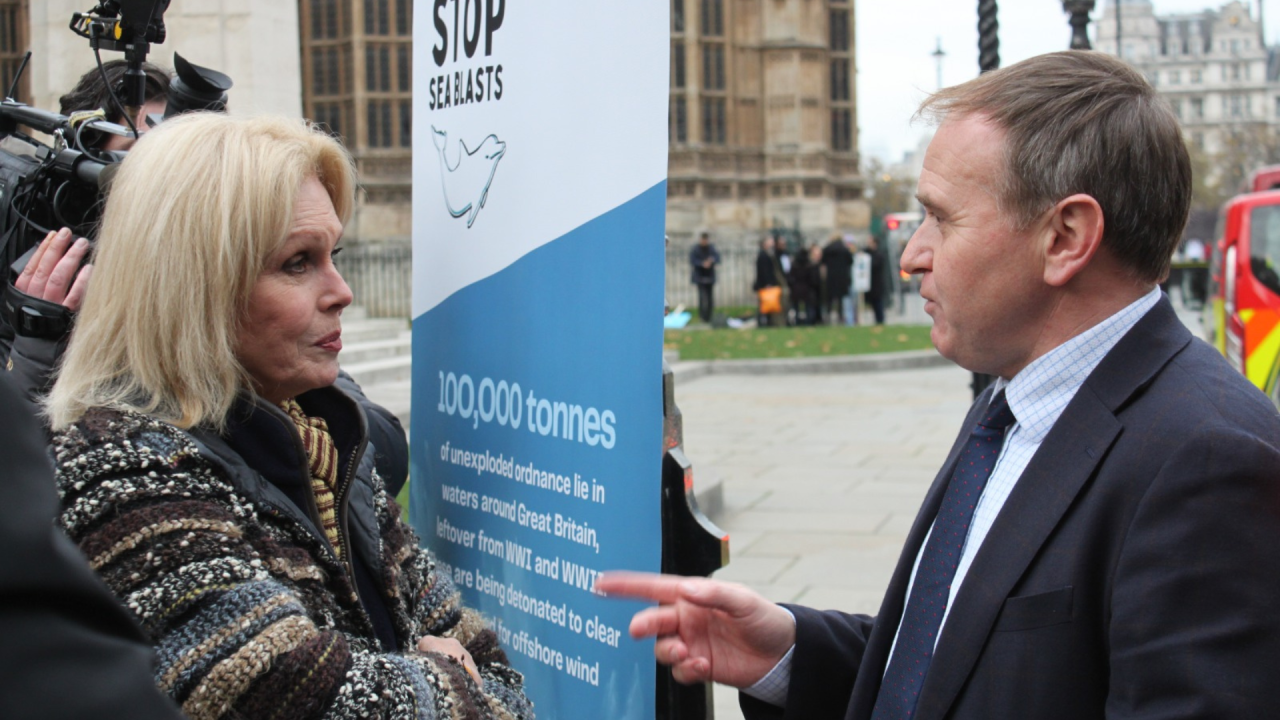Tendo are delighted to announce the success of the Stop the Sea Blasts campaign and welcomes the Government’s announcement and commitment to implementing new measures to curb underwater noise and accelerate renewable energy.
Our Director, Peter Carroll, provides some insight below on the art of campaigning on a ‘ultra niche’ issue and details the sheer amount of work dedicated to making this campaign an overwhelming success.
“Like I guess many of us do on this platform, I subscribe to the view that the variety of issues, challenges and campaigns that one can end up dealing with in the world of government relations and PR is one of the main reasons that working in our field is so fulfilling.
And I guess we’ve all come across examples which ‘stretch’ that spectrum of variety a little further than normal.
We at Tendo were extensively involved in one such that has, to all intents and purposes, just crossed the line of victory in the form of the Government announcement – https://www.gov.uk/government/news/new-measures-to-curb-underwater-noise-and-accelerate-renewable-energy
In the grand scheme of things I think the majority of folk would agree that the issue at hand could legitimately be classed as ‘ultra niche’.
I set out here some insights into this campaign success in the hope that they might be useful for anyone facing the campaigning challenge of taking on similarly niche/technical issues and persuading Government to act.
The famous British actor Michael Caine is widely mimicked, and those doing the mimicking almost invariably use the phrase in his voice of, ‘Not a lot of people know that’. It’s a phrase that popped into the collective head of the Tendo team quite often in the early days of the campaign! To demonstrate the niche nature of this issue, I wonder if the thought ‘Gosh – Not a lot of people know that’ rings true in your own mind when I explain the background to this particular campaign.
There’s around 330,000 items of unexploded munitions (bombs, torpedoes, mines, depth charges, shells) scattered around UK coastal waters. Many of these result from the Second World War and are in what might be described as a ‘delicate’ state after years of attack by sea water. Personally, I was astonished by the size of that number.
But you might well ask, ‘what’s the harm?’ Maybe they should just be left there undisturbed. However, the problem is that like many countries with sea borders, the UK is committed to a massive expansion of offshore wind with all the construction and cable works that entails. It doesn’t take an expert in munition clearance to see that pile-driving a wind turbine base, or laying an undersea cable, near an unexploded bomb is not ideal. And so, there is an ever growing need to make sure that any such unexploded munitions near such planned works are made safe.
Making an unexploded subsea munition safe is very specialised work undertaken by highly skilled professionals. I met with several of them during the course of this project. They had that peculiar mix of good humour and relaxed manner that people sometimes have who are engaged in what most of us would regard as outrageously risky work. Many are ex-military, all command my absolute respect. It’s most certainly not a job I’d want to try.
I guess we’ve all seen the video clips on the news when specialist contractors or the military are brought in to make a bomb safe. Invariably, the clip shows expectant onlookers poised on the shore who then gasp and cheer as the offending munition is literally ‘blown up’. There’s a deafening ‘bang’ and a skyscraper size plume of sea water blasted into the sky.
So all good then? We can clear these under sea ‘nasties’ by placing an explosive charge next to them which is then detonated, and that explosion then detonates the offending item.
But it’s not that simple. The shock wave from these so called ‘high order’ detonations is enormous. And under water, it travels many, many kilometres. That shock wave causes immense damage to marine life. In particular, it damages the auditory systems of whales, dolphins and the like. These creatures rely on their hearing for navigation and hunting food. It is widely accepted that the shock waves from clearing under sea munitions by simply detonating them in this way causes mass strandings and other untold suffering, harm and death amongst the sea mammal population.
So, what’s to be done? We have the conflicting need to develop offshore wind for all the right reasons of tackling climate change, with the need to protect our wonderful sea mammal population.
Enter an amazing technology! And get ready for one of the least ‘snazzy’ names for a technological innovation – ‘Low Order Deflagration’. Yes, that’s quite a mouthful isn’t it.
This technology has been in use by navies around the world for a number of years but it wasn’t widely known about, understood or used in commercial or non-military government circles.
It’s simply brilliant. It’s a way of making a munition safe by ‘burning it out’ rather than blowing it up. There’s no ‘big bang shock wave’. No massive plume of sea water. No scarring of the seabed as is common with the old way of simply blowing up unexploded munitions. The lack of the ‘big bang’ is why it’s referred to as ‘low order’. And the ‘burning out’ explains the ‘deflagration’ bit.
Working with those in the sector passionate about conserving and protecting nature such as the team EODEX our mission was to put together a fully integrated media, public, parliamentary and government engagement campaign that would apply pressure to Government to make this new way of doing things standard.
So first, we needed to make some big strategic decisions. How do we make this highly technical issue something that can command attention from the media, the public and the general ‘body politic’?
Our first significant decision was to make this issue not about ‘unexploded subsea munitions and high order vs low order’, but to make it about protecting sea life, in particular, whales dolphins and other large sea mammals. This conditioned all our messaging.
Sometimes, the involvement of a high-profile celebrity with impeccable authentic links to the issue can ‘super charge’ public, media, and parliamentary engagement. And this proved to be the case in this instance. Joanna Lumley has a long track record of environmental and conservation activism. I recall asking her advice as to who she may know who would be interested in helping head up our campaign. To my delight, rather than recommend anyone else, she immediately said that this was something she cared passionately about and would take the lead on.
We also reached out and gained support from charities – Whale and Dolphin Conservation , World Cetacean Alliance Marine Connection and Advocating Wild who very kindly agreed to work with us as they saw a positive outcome to our endeavours as being of significant benefit to the marine environment.
And so, the Stop Sea Blasts campaign was born.
And what a ride it has been!
Joanna’s involvement helped us secure coverage across a whole range of public facing media outlets, rather than the trade press that would normally be the home of such a technical issue. These included the Jeremy Vine Show, The Today Programme, Good Morning Britain, The Times, The Daily Express and many, many more. By utilising this dynamic media, combined with a curated programme of social media activity, we developed an online community of over 120,000 people. This community proved critical as they worked with us to raise the issue to parliamentarians. In turn, this parliamentary pressure allowed us to secure engagement with the relevant Ministers.
As ever with any campaign that’s ‘going places’, there was an element of fun too. I don’t think I’ll ever forget being told by the parliamentary authorities with 3 hours notice that the sudden re-imposition of Covid restrictions in the early days of the campaign meant we couldn’t do our ‘drop in event’! In the end, we did it anyway outside, by a lamp post in Old Palace Yard complete with Joanna, about 80 MPs and Peers and the Secretary of State Rt Hon George Eustice. Or the fabulous site visit during which Joanna and the Secretary of State ‘blew’ various things up.
But behind the ‘fun’ and the high-level media and parliamentary engagement were many, many hours of very detailed technical discussions and meetings with the various civil servants and representatives of various government technical and scientific agencies such as the Defence Science Technology Laboratory Dstl , JNCC and of course Department for Environment, Food and Rural Affairs and the Marine Management Organisation and their devolved equivalents.
It’s taken some years to get to this point. Some might argue that Government was too slow to make this move. In their defence, I accept they have a lot of moving parts of government to bring together and the issues are indeed quite technical.
However you look at it, we’ve gone from a situation in which Second World War technology was being routinely used causing great harm to sea life, to one where a much more environmentally friendly technology will be used.
It’s been a joy to be associated with such a great cause. All the team here enjoyed the public affairs challenge of developing a strategy and execution plan in such a niche and technical area and driving it through to completion. And it was particularly sweet to receive an email from DEFRA letting us know of this most recent development replete with the line ‘Stop Sea Blasts were instrumental in the policy.”
If you’re facing similar challenges and feel talking it through would be useful, we’d love to hear from you. Please contact hello@tendoconsulting.co.uk for further enquiries.



